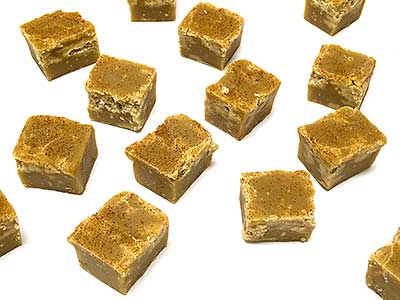July 1, 2013
Mignardise

fondant au caramel
(penuche)
What if we called it a different, not so polite, expletive that starts with an “F”? Do you think people would love it as much? Fudge sounds like a curse imposed by a censor. It doesn’t sound like what an honest person would say when they make a mistake.
The first batch of fudge is believed to have been a mistake that happened somewhere in the Northeastern United States in the second half of the nineteenth century. My guess is that the person was trying to make a fondant, and fudge was a result. Others believe that it was a batch of caramels, and fudge was the result. At least fudge, as it was prepared back then, was the result.
There are a lot of different types of fudge from vanilla to chocolate, with nuts or fruit or without, flavored with peanut butter and other things or not, made with white sugar or brown, and from “true” fudge to something else still called fudge.
I was never really a fan of fudge until I made the recipe from Fanny Merritt Farmer’s first Boston Cooking-School Cook Book (1896).
Melt one tablespoon butter, add one-half cup milk and one and one half cups sugar; stir until sugar is dissolved, than add five tablespoons prepared cocoa, or two squares of unsweetened chocolate. Stir constantly until chocolate is melted. Heat to boiling point and boil twelve minutes, stirring occasionally to prevent burning. Extinguish flame, add one teaspoon vanilla, and beat until the mixture is creamy. Pour into a buttered pan, cool, and mark in squares.
It was old-style. Even though an attempt was made to control crystal development, it was grainy. It melted in my mouth. I don’t appreciate modern, smooth fudges that have sugar crystals that are too small to notice and recipes that are too complicated to follow.
Although I have heard of Divinity Fudge, which some claim is not a true fudge, and have eaten more than my share of ordinary chocolate fudge, penuche is new to me. Last Christmas, a friend posted an article on her blog about it. It’s brown-sugar fudge. If you are like me—when I was a child, I used to steal spoonfuls of brown sugar from my mother when her back was turned—then this is the fudge for you.
Other than making only half as much—I cook mignardise quantities—and substituting heavy cream for half-and-half, I made the recipe very close to my friend’s version. My other exception is that instead of beating the mixture in my Step 4 for three to five minutes until thick and smooth, I beat just until everything is incorporated. The longer beating time is one of the tricks used to minimize the size of the sugar crystals. Since I’m after a gritty texture, I keep this step to a minimum.
150 g (3⁄4 c)
dark brown sugar
70 g (5 T)
unsalted butter
75 ml (5 T)
heavy cream
pinch
fine salt
1⁄2 t
vanilla extract
30 g (1⁄4 c)
powdered sugar
ground cinnamon, to taste
1. Line an 11 by 14 cm (4-1⁄3 by 5-1⁄2 in), or similar size, cake pan with plastic wrap.
2. Place the brown sugar, butter, cream, salt, and vanilla into a heavy-bottomed saucepan, and set over medium heat. Bring to a boil, stirring occasionally with a wooden spatula or spoon to melt and combine the ingredients.
3. Continue to cook the mixture until it reaches 114 °C (237 °F). Remove from the heat.
4. Stir in the powdered sugar, and beat with a wooden spatula or spoon until smooth. See note below.
5. Pour the mixture into the prepared cake pan. Sprinkle the surface immediately with the cinnamon. Set the cake pan on a level surface in your refrigerator until the penuche is cold and firm.
6. When cold and firm, remove from the cake pan. Cut into squares or rectangles, as is your preference.
Note: How long you beat in step 4 will determine how gritty your finished penuche is. I do it only until the powdered sugar is mixed in. The mixture will still be easy to pour. If you beat until the mixture is thick, about 5 minutes, you’ll need to spread the mixture out with a spatula.
Yield: Depends on how big you cut your pieces. I get about 120 1-cm squares from one batch.
© 2013 Peter Hertzmann. All rights reserved.
